Philips Hue smart lights: pricey but worth it, right? That’s the line I usually spout when it comes to the Hue smart lighting brand, but with its latest wave of product announcements, Hue is showing a renewed interest in budget-minded smart home users.
Sure, Hue still had some big-ticket items (most of which were leaked by Hue itself earlier this month) to show off during its IFA press conference this week. For starters, there’s the new Hue Bridge Pro, a $90 revamp of the (still available) Hue Bridge V2 that can handle many more smart devices as well as turn your Hue lights into motion sensors.
Hue also trotted out a premium color light strip that crams in so many LEDs it’s virtually a single, unbroken strip of light, along with a new video doorbell, a wired security camera with upgraded video resolution, and its first stab at permanent outdoor lights.
But Hue also did something different this year, unveiling an “Essential” line of affordable (!) smart lights with “basic” specifications. The pared-down lighting capabilities of Hue’s new Essential line is sure to raise eyebrows among loyal Hue customers accustomed to the brand’s high standards—and higher prices. Still, Hue is promising that its Essentials products will bridge the affordability gap “without compromising reliability.”
Philips Hue Bridge Pro
Before we get to the cheaper Essential line, let’s cover Hue’s bread-and-butter premium products, including the step-up Hue Bridge Pro.
Slated to go on sale this month for $90, the Hue Bridge Pro offers three big reasons to upgrade: a vastly improved capacity and much greater power than the aging Hue Bridge V2; the ability to turn your existing Hue lights into motion sensors; and Wi-Fi connectivity to eliminate the need to hardwire the hub to your router with an ethernet cable (although an ethernet port is still there if you want it). Hue executives say the Bridge Pro’s security has been hardened to prevent wireless-based hacks.
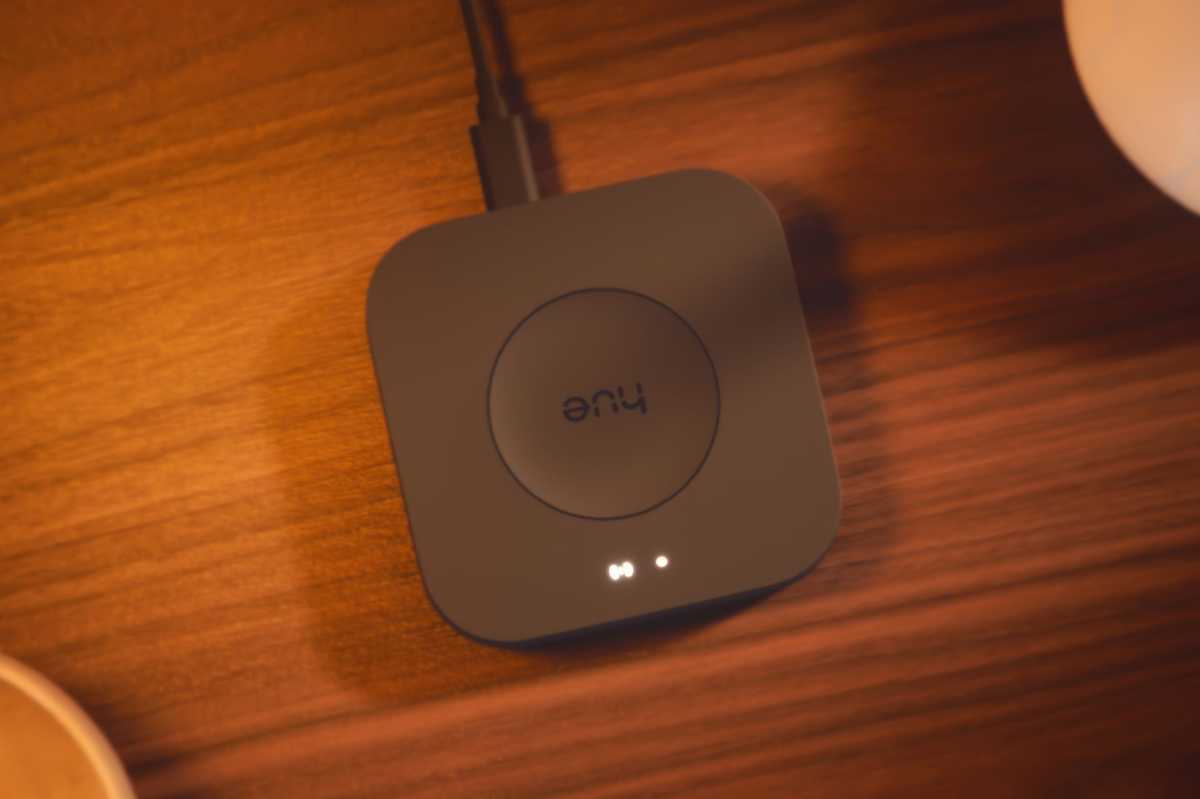
Philips Hue
Now packing a 1.7GHz quad-core Cortex A-35 GPU and a gigabyte of DDR4 SDRAM, the Bridge Pro can juggle more than 150 Hue lights as well as 50-plus Hue accessories, way up from the 60-ish device limit of the current Bridge V2. That should come as a relief to longtime Hue users with ever-growing collections of indoor and outdoor Hue lights, Hue sensors, and (now) Hue security cameras.
Even cooler, the Bridge Pro boasts a feature called Motion Aware, which can turn your existing Hue lights into motion sensors. To use the feature, you’ll need at least three Hue lights (roughly 95 percent of existing Hue lights are Motion Aware-capable, Hue says) in a defined area. If your lights sense a motion disturbance or the lack thereof, they’ll be able to trigger either standard light routines (as in turning on your lights when you enter a room) or security-minded automations (like alerting you to a potential intruder). While motion-triggered light routines will be free, security-based motion automations will require subscribing to a paid Hue Secure plan.
You’ll be able to migrate your entire Bridge V2 configuration to a new Bridge Pro in just a few taps via the Hue app. You can also move lights and accessories to the Bridge Pro manually, while the ability to merge multiple Hue Bridge configurations into a single Bridge Pro is coming later this year.
One feature the Bridge Pro is not adding is a Thread border router, with Hue execs explaining that they believe Zigbee offers “the best performance for our use cases.” That said, the Bridge Pro (along with the older Bridge v2) can bridge Hue lights into Matter controller apps, and—as we’ll see in a moment—Hue is adding Thread radios to its newer bulbs to work “in parallel” with Zigbee and Bluetooth.
New Philips Hue light strips, outdoor lights, and A19 bulbs
Besides its new premium hub, Philips Hue had some premium lights to show off, starting with its top-of-the-line, 4,500-lumen Hue OmniGlow strip light.
Slated for release in November and starting at $140 for a 3-meter strip (a 10-meter version costs a whopping $350), the OmniGlow strip light employs chip-scale package technology that allows it to cram more than 170 LED dies per square inch (with each LED measuring less than a half millimeter across). By “packing these LEDs incredibly densely,” the OminGlow strip light promises to look like a single strip of light rather than a strip with clearly defined diodes.
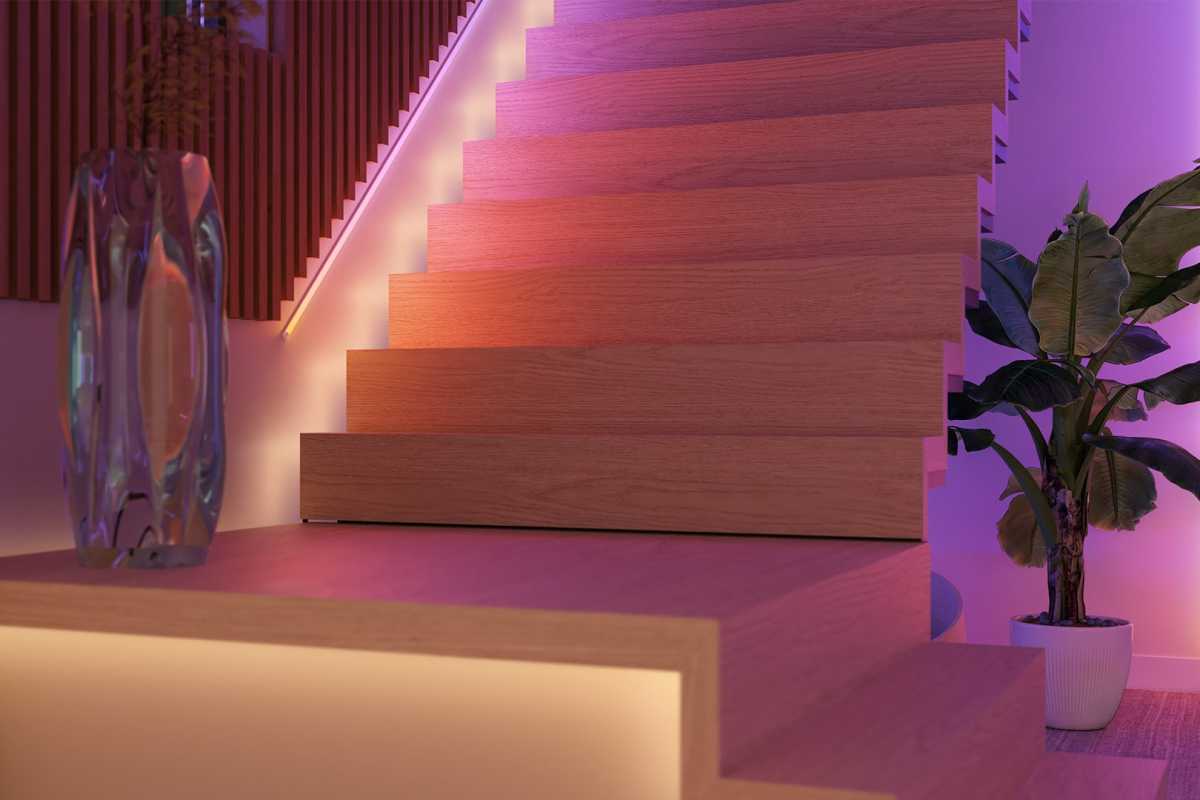
Philips Hue
Hue is offering six more light strip models alongside the OmniGlow, including the Flux indoor strip light, the Flux ultra bright, a Flux outdoor strip light, and a flexible “neon” light strip, with prices ranging from $70 for the 3-meter indoor Flux strip light to $250 for the $250 for the 10-meter Hue neon outdoor strip.
Then there’s the Festavia line of indoor/outdoor string lights, which is spawning both a globe light version ($160 for a seven-meter string, due in September) as well as permanent outdoor lights (also arriving in September, $119 for 9 meters and $300 for 18 meters).
Finally, a revamped A19 bulb (ranging from $16 for a 60W white bulb to $80 for a 100W White and Color Ambience version, with tunable White Ambience bulbs in the middle) lands with 40-percent greater efficiency than its predecessor, dimming that goes all the way down to 0.2 percent, and (as mentioned above) native Matter-over-Thread support.
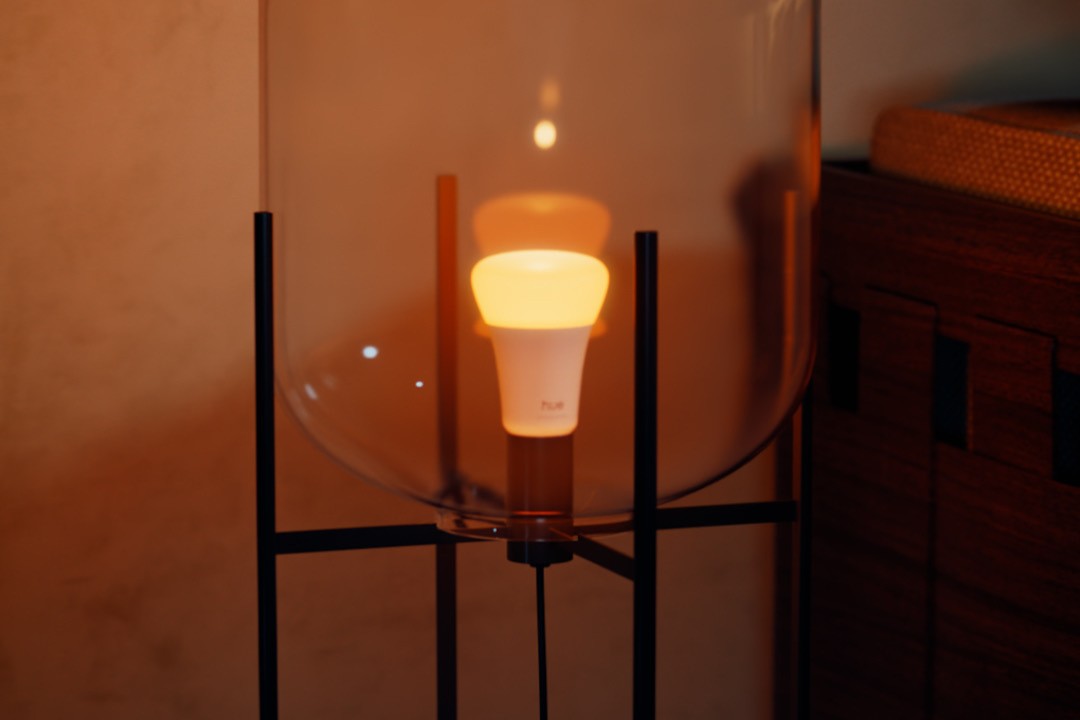
Philips Hue
New Philips Hue Secure cameras
Hue is doubling down on its new home security products with its first video doorbell. Boasting 2K video resolution (up from 1080p for its earlier security cams), the Hue Secure Video doorbell ($170, set for October release) has a 180-degree head-to-toe field of view, along with two-way talk and a Starlight sensor for night vision. A smart chime ($60, also slated for October) that plugs into a standard wall outlet will also be available.
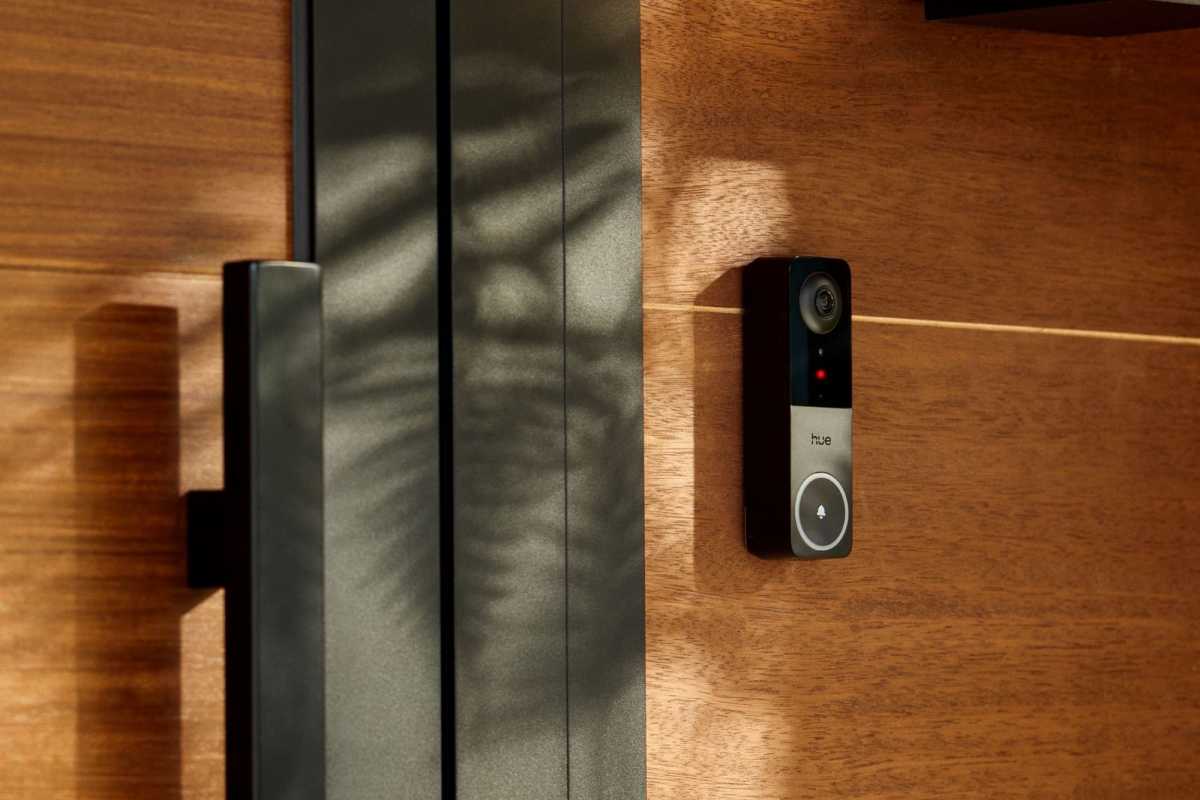
Philips Hue
Also new is an upgraded wired camera ($180 in black or white, October) with 2K video resolution, same as the video doorbell.
Aside from the new Secure hardware, Hue says it will soon offer 24 hours of video history for free, without a Hue Secure subscription (heads up, Nest and Ring), along with smoke alarm detection as well as independent light and sound alarms.
The affordable Hue Essential line
So much for all the premium Hue products. Now it’s time for some Hue lights that are—finally—a lot less pricey.
The new Hue Essential line comprises a range of standard form factors, from A19 bulbs and BR30 floodlights to GU10 downlights and a light strip. The 60W A19 color bulb (set to arrive this month) connects via Zigbee, Matter-over-Thread, or Bluetooth, and costs a mere $25 versus $60 for the cheapest Hue White and Color Ambience bulb. The 65W BR30 also sells for $25, as does the 50W GU10 bulb. A five-meter Essential light strip will go for $100, with the 10 meter-version costing $170.
A wide range of Essential starter kits will be available too; for example, a kit with two bulbs, a Hue Switch, and the Bridge V2 will have a list price of $90.
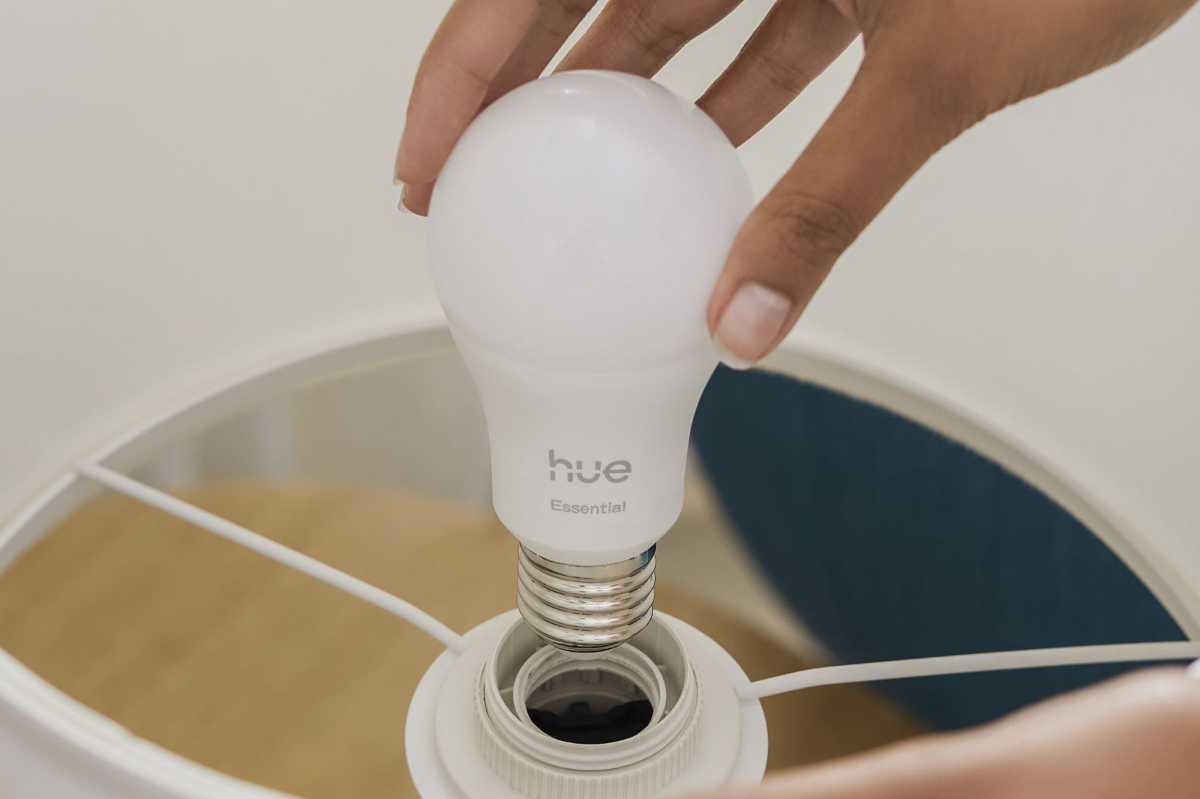
Philips Hue
What compromises will the Essential line entail? For starters, the lowest dimming setting for an Essential bulb will be 2 percent, compared to 0.2 percent for an equivalent Hue light, while the cheaper bulbs will make do with “essential” color blending and quality rather than “perfect” color blending (via Sunflower Optic technology) or “premium” color quality (thanks to Hue’s ChromaSync tech) for Hue’s premium bulbs.
So yes, Hue’s premium bulbs will indeed be “premium” compared to the Essential line, but newcomers to the Hue ecosystem might be tempted by the lower cost of entry for a Hue color bulb. Meanwhile, more experienced Hue users (like me) might be more willing to snag a less expensive Hue Essential color bulb for locations that didn’t previously merit the cost of a premium White and Color Ambiance light.
Last but not least: Sonos voice control
One final item that has been previously leaked: Yes, Sonos voice control is coming to Hue, allowing Hue users to use Sonos voice commands to turn Hue lights on and off, adjust their brightness, and set lighting scenes.
For now, Sonos integration is restricted to voice control only; that is, you won’t be able to see Sonos speakers within the Hue app, nor will Hue lights be available within the Sonos app.
This news story is part of TechHive’s in-depth coverage of the best smart lights.
Accedi per aggiungere un commento
Altri post in questo gruppo


When you’re in a hurry and tossing USB cables into your bag, it’s eas

Let’s be honest. Your phone probably doesn’t have enough storage spac

No professional sport has been more savvy and enthusiastic about offe

Nowadays, your home or office setup can feature a mini PC without iss

If you were paying extra for ESPN+, you might not need to anymore.

Govee is upping the ante with its latest TV backlight kit, adding a t
